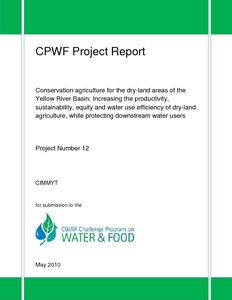Resource information
Soil erosion is a major problem in the Yellow River Basin: the river is one of the most
sediment-laden in the world. Although there is a rainfall gradient from 750 mm in southern
Shandong, to 200mm per year in northern Ningxia, most of the rainfed cropping area is in
regions with more than 400 mm per year – it is here that the project concentrated.
Conservation agriculture (featuring reduced or zero tillage, mulch retention, crop rotations
and cover crops) offers a possible solution to problems of soil erosion and low crop
productivity. Conservation agriculture (CA) systems typically result in increased crop water
availability and agroecosystem productivity, reduced soil erosion, increased soil organic
matter and nutrient availability, reduced labor and fuel use and increased biological control
of pests. Most of the recent advances in conservation agriculture in China have been in
irrigated areas, from which technologies and approaches were adapted for this project.
The project goal was to improve the incomes and livelihoods of smallholder farm families in
the rainfed cropping areas of Henan, Inner Mongolia, Ningxia and Shandong (Shanxi was
added later) while simultaneously improving soil quality and reducing land degradation and
soil erosion that threaten system sustainability. Specific objectives included fostering farm
family adoption of conservation agriculture practices through participatory research,
farmer experimentation and farmer-to-farmer interaction and extension; assessing the
(biophysical, social and economic) consequences of conservation agriculture adoption;
encouraging a policy environment that does not discriminate against conservation
agriculture; and strengthening the capacity of local partners. Project partners include two
international Centers (CIMMYT and IWMI), Provincial and County NARES, and Universities.
Project beneficiaries were expected to include farm families; downstream water users;
researchers and extension workers; and future generations.


